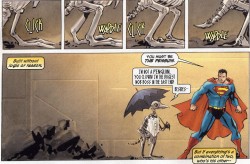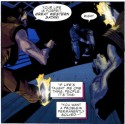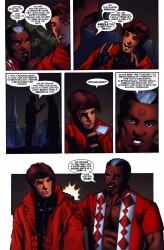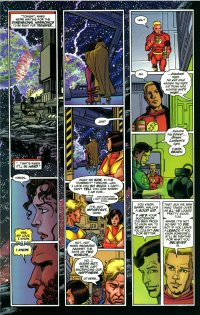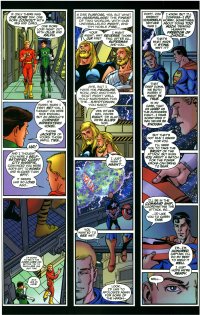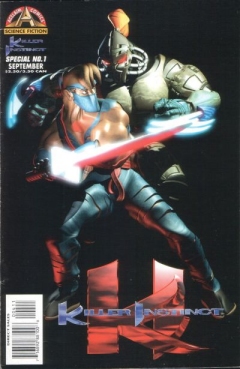When I started this, I didn’t expect to read about Ogami Itto mowing down several people with a shotgun. However, he did, I did, and now I get to tell you about it.
Volume 5, Black Wind, has five stories this time: “Trail Markers,” “Executioner’s Hill,” “Black Wind,” “Decapitator Asaemon,” and “The Guns of Sakai.” I found “Trail Markers” to be pretty snooze-worthy. It’s a short tale, just thirty pages, and it’s almost like a recap/infodump of sorts. We find out how Ogami finds his clients, which seems to be based entirely around luck and being in the right place at the right time. The Yagyu clan reveals that it has been around two years since their last encounter, and that the shogunate has heard rumors of Ogami’s current status and how he came to be there. They’re beginning an investigation, which means that it may be the end of the road for the Yagyu clan.
And you know, this story was pretty boring. I realize that it sets up “Decapitator Asaemon,” but it could’ve just been left out with no issue at all. We see Retsudo, and he’s menacing, and they send people out to kill Ogami. He effortlessly dispatches him and reiterates the fact that he doesn’t care about the life of a samurai any more. His way is death, he knows only meifumado, blah blah blah.
“Executioner’s Hill” fares somewhat better, but still ends up being predictable. We meet the Zodiac Gang, they see Ogami, they realize that he’s the guy who decapitated their lord back when he was kogi kaishakunin, and decide that they want revenge. They lure Daigoro away with the sound of the drum that candy salesmen use, which was a fascinating reveal, and then attack Ogami. He dispatches them easily.
“Executioner’s Hill” had one moment that stood out to me. When Ogami realizes that Daigoro is being kidnapped, he rushes after him. Once he catches up to the gang, and they threaten Daigoro, Ogami simply tells them to kill his son. All that will remain are corpses in the sand. The Zodiac Gang call him out on this, since meifumado is supposed to be emotionless and hard. Why did he show concern for his son?
 Ogami explains that he was simply following natural law. It is the nature of man to avoid danger and death. However, once you are in the midst of it, the only sensible thing to do is embrace it and approach the situation with a clear mind. I thought this was the best part of the story, as it explained something that genuinely needed an explanation.
Ogami explains that he was simply following natural law. It is the nature of man to avoid danger and death. However, once you are in the midst of it, the only sensible thing to do is embrace it and approach the situation with a clear mind. I thought this was the best part of the story, as it explained something that genuinely needed an explanation.
“Black Wind” was my favorite of the book, for the exact same reason I liked volume 4 so much. It dealt with Daigoro more than Ogami, and in doing so, revealed something about the life the father and son are leading. It opens with Ogami working in a rice paddy with the women of a village. Daigoro is not confused, exactly, but he looks at Ogami as a “new father,” as he’d never seen this side of Ogami before. He enjoys it very much, and for the first time, he wants to do what his father does. He never gave a thought to being an assassin, but this looks good. It makes him warm.



We’re treated to more of Daigoro throughout the story. He finally gets to pick with the women and his father, and he enjoys it. He eats dinner with some members of the village, and they’re all impressed at his poise and manners. He’s an exceptional child, and it shows. He smiles. And then, when men come to the village and threaten his father, the boy’s face turns empty again and shishogan sets in.



The revelation of why his father is doing the planting, which is considered beneath the status of even a ronin, is fascinating, as well. A young girl was killed by accident during the course of his quest, and her dying words were thoughts of her family and hometown. While doing the planting, Ogami buried strands of her hair with the rice. It was a surprisingly tender turn, and shows that Ogami still has some sense of decency.
“Decapitator Asaemon” is straightforward. The shogunate sends Asaemon, the third best swordsman in the land, to investigate and find out if Ogami has genuinely become an assassin. Retsudo interferes with their battle, and Asaemon dies. Nothing particularly special here, though it does set up Samurai Executioner, another Koike/Kojima production.
“The Guns of Sakai” is… something else. There’s a lot of talk about what it means to be a man, to innovate, and to be honorable in it. I really enjoyed it. It features an expert gunsmith, one of the subordinates of the five gunsmiths of Sakai, the official gunsmiths of the shogunate. He’s under inspection because he is creating new weapons without the permission of the shogunate.
Ogami catches up with him, and grants him one last request. He speaks to his apprentices of honor, of innovation, and of what the soul of a gun is. He curses the shogunate and the fact that guns went from being killing machines to expensive ornamental pieces of stagnated junk. Later, he reveals that he knows that they sold him out and kills them. Before Ogami kills him, he declares that Ogami should use this new weapon and keep the plans for a repeating gun.
That, of course, leads to this, when the five gunsmiths catch up to him:






And well, there it is. Volume 6 next week. I won’t be sick, so it should be up on time.










